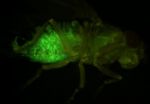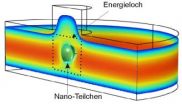(Press-News.org) By studying fruit flies, scientists at A*STAR's Institute of Molecular and Cell Biology (IMCB) have successfully devised a fast and cost-saving way to uncover genetic changes that have a higher potential to cause cancer. With this new approach, researchers will now be able to rapidly distinguish the range of genetic changes that are causally linked to cancer (i.e. "driver" mutations) versus those with limited impact on cancer progression. This research paves the way for doctors to design more targeted treatment against the different cancer types, based on the specific cancer-linked mutations present in the patient. This study published in the prestigious journal Genes & Development could help advance the development of personalised medicine in cancer care and treatment.
The era of genomic sequencing has generated an unparalleled wealth of information on the complexity of genetic changes that occur as cancer develops and progresses. "Many genetic changes arise in cancer cells and changes continue to accumulate during the progression of disease to metastatic cancer [1]. The current challenge is to understand which of the many genetic changes are important drivers of disease progression" said Dr. Stephen Cohen, Principal Investigator at IMCB and team leader of this paper.
Though very different in many ways, fruit flies and humans share similarities in a remarkable two-thirds of their genomes. That is to say, many of the genes found in humans are also present in the flies. Similarly, various signalling pathways involved in tumour formation are also well conserved from fruit flies to humans. In fact, previous studies have shown that about 75 percent of known human disease genes have a recognisable match in the genome of fruit flies [2].
Leveraging on their genetic similarities, Dr Héctor Herranz, a post-doctorate from the Dr Cohen's team developed an innovative strategy to genetically screen the whole fly genome for "cooperating" cancer genes. On their own, these are the genes that appear to be harmless and have little or no impact on cancer. But in fact, they cooperate with other cancer genes, so that the combination causes aggressive cancer, which neither would cause alone.
In this study, the team was specifically looking for genes that could cooperate with EGFR [3] "driver" mutation, a genetic change commonly associated with breast and lung cancers in humans. SOCS5, reported in this paper, is one of the several new "cooperating" cancer genes to be identified through this innovative approach. Most of these new-found genes have yet to be identified as cancer genes in human or mouse models.
Said Mr Xin Hong, a PhD student and the co-first author of this paper, "We were very surprised by our finding because this it the first time that the Socs gene family is found to be linked to cancer. Previously it has only been associated with immunological disorders."
Dr. Cohen added, "Though these studies are in the early stages, they are very promising. Already, there are indications that levels of SOCS5 expression are reduced in breast cancer, and patients with low levels of SOCS5 have poor prognosis."
The IMCB team is preparing to explore the use of SOCS5 as a biomarker in diagnosis for cancer.
Said Professor Wanjin Hong, Executive Director of IMCB, "This study sheds light on the complexities of cancer genetics and paves the way to accelerate development of personalised medicine in cancer care. It is a fine examples of how powerful genetic approach using the fly model can reveal molecular mechanisms underlying human cancer. More importantly, it shows how fundamental research can have far-reaching applications for potential clinical benefits."
INFORMATION:
Attached Figure caption: Researchers at IMCB are using fruit fly as a genetic model to accelerate the discovery of novel cancer genes. The picture shows metastatic tumours spreading throughout the fly body (visualised by the green fluorescent proteins) when one of the newly found "cooperating" cancer genes are removed in combination with an activated EFGR "driver" mutation.
Footnotes:
[1] Cancer metastasis is the rapid and often fatal spread of cancer cells from the primary tumour to other parts of the body, and is often the leading cause of death by cancer.
[2] Reiter, LT; Potocki, L; Chien, S; Gribskov, M; Bier, E (2001). "A Systematic Analysis of Human Disease-Associated Gene Sequences In Drosophila melanogaster" Genome Research 11(6):1114-1125 http://www.ncbi.nlm.nih.gov/pmc/articles/PMC311089/?tool=pmcentrez
[3]Epidermal growth factor receptor (EGFR) is a cell surface protein that binds epidermal growth factor binds, causing cells to divide. It is found at abnormally high levels on the surface of many types of cancer cells, so that these cancer cells may divide excessively in the presence of epidermal growth factor
Notes for editor:
The research findings described in this media release can be found in the 15 July 2012 issue of Genes & Development under the title, "Oncogenic cooperation between SOCS family proteins and EGFR identified using a Drosophila epithelial transformation model" Héctor Herranz1,5, Xin Hong1,2,5, Nguyen Thanh Hung3, P. Mathijs Voorhoeve3,4 and Stephen M. Cohen1,2,6
1 Institute of Molecular and Cell Biology, Singapore 138673, Singapore;
2 Department of Biological Sciences, National University of Singapore, Singapore 119613, Singapore;
3 Duke-NUS (National University of Singapore) Graduate Medical School, Singapore 169857, Singapore;
4 Department of Biochemistry, National University of Singapore, Singapore 119613, Singapore
5 These authors contributed equally to this work.
6 Corresponding author, E-mail: scohen@imcb.a-star.edu.sg
Full text of this article can be accessed from http://genesdev.cshlp.org/content/26/14/1602.full.pdf+html
AGENCY FOR SCIENCE, TECHNOLOGY AND RESEARCH (A*STAR)
For media queries and clarifications, please contact:
Dr. Sarah Chang
Corporate Communications
Agency for Science, Technology and Research
Tel: (65) 6826 6442
Email: chang_kai_chen@a-star.edu.sg
About Institute of Molecular and Cell Biology (IMCB)
The Institute of Molecular and Cell Biology (IMCB) is a member of Singapore's Agency for Science, Technology and Research (A*STAR) and is funded through A*STAR's Biomedical Research Council (BMRC). It is a world-class research institute that focuses its activities on six major fields: Cell Biology, Developmental Biology, Genomics, Structural Biology, Infectious Diseases, Cancer Biology and Translational Research, with core strengths in cell cycling, cell signalling, cell death, cell motility and protein trafficking. Its achievements include leading an international consortium that successfully sequenced the entire pufferfish (fugu) genome. The IMCB was awarded the Nikkei Prize 2000 for Technological Innovation in recognition of its growth into a leading international research centre and its collaboration with industry and research institutes worldwide. Established in 1987, the Institute currently has 26 independent research groups, eight core facilities and 300 researchers.
For more information about IMCB, please visit www.imcb.a-star.edu.sg
About the Agency for Science, Technology and Research (A*STAR)
The Agency for Science, Technology and Research (A*STAR) is the lead agency for fostering world-class scientific research and talent for a vibrant knowledge-based and innovation-driven Singapore. A*STAR oversees 14 biomedical sciences and physical sciences and engineering research institutes, and six consortia & centres, located in Biopolis and Fusionopolis as well as their immediate vicinity.
Fruit flies light the way for A*STAR scientists to pinpoint genetic changes that spell cancer
By studying fruit flies, scientists at A*STAR's Institute of Molecular and Cell Biology have successfully devised a fast and cost-saving way to uncover genetic changes that have a higher potential to cause cancer
2012-07-30
ELSE PRESS RELEASES FROM THIS DATE:
A giant step in a miniature world: UZH researcher measures the electrical charge of nano particles
2012-07-30
In order to observe the individual particles in a solution, Prof. Madhavi Krishnan and her co-workers «entice» each particle into an «electrostatic trap». It works like this: between two glass plates the size of a chip, the researchers create thousands of round energy holes. The trick is that these holes have just a weak electrostatic charge. The scientists than add a drop of the solution to the plates, whereupon each particle falls into an energy hole and remains trapped there. But the particles do not remain motionless in their trap. Instead, molecules in the solution ...
Archaeologists from Bonn discover in Mexico the tomb of a Maya prince
2012-07-30
Archaeologists from the Department of Anthropology of the Americas at the University of Bonn have been excavating for the past four years together with the Mexican National Institute of Anthropology and History in the Maya city of Uxul in Campeche, Mexico. The aim of the excavation project under the direction of Prof. Dr. Nikolai Grube and Dr. Kai Delvendahl is to investigate the process of centralization and collapse of hegemonic state structures in the Maya Lowlands using the example of a mid-sized classic Maya city (Uxul) and its ties to a supra-regional center (Calakmul). ...
Telling the tale of the wealth tail
2012-07-30
A mathematical physicist and her colleague, both from the Free University of Bozen-Bolzano, Italy, are about to publish a study in EPJ B¹ on a family of taxation and wealth redistribution models. The findings could lead to numerical simulations of potential wealth distribution scenarios playing out over the long term and could be used for policy decision making.
Maria Letizia Bertotti and Giovanni Modanese propose a mechanism of individual interaction of economic agents involved in wealth redistribution on a one-to-one level as a means of understanding their collective ...
Brain development is delayed in attention-deficit/hyperactivity disorder
2012-07-30
Philadelphia, PA, July 30, 2012 – Is attention-deficit/hyperactivity disorder (ADHD) due to a delay in brain development or the result of complete deviation from typical development? In the current issue of Biological Psychiatry, Dr. Philip Shaw and colleagues present evidence for delay based on a study by the National Institutes of Health.
The cerebral cortex is the folded gray tissue that makes up the outermost portion of the brain, covering the brain's inner structures. This tissue has left and right hemispheres and is divided into lobes. Each lobe performs specific ...
Archeologists unearth extraordinary human sculpture in Turkey
2012-07-30
A beautiful and colossal human sculpture is one of the latest cultural treasures unearthed by an international team at the Tayinat Archaeological Project (TAP) excavation site in southeastern Turkey. A large semi-circular column base, ornately decorated on one side, was also discovered. Both pieces are from a monumental gate complex that provided access to the upper citadel of Kunulua, capital of the Neo-Hittite Kingdom of Patina (ca. 1000-738 BC).
"These newly discovered Tayinat sculptures are the product of a vibrant local Neo-Hittite sculptural tradition," said Professor ...
In Massachusetts, 'individual mandate' led to decreased hospital productivity
2012-07-30
Philadelphia, Pa. (July 30, 2012) - As the "individual mandate" of the Affordable Care Act moves forward, debate and speculation continue as to whether universal health insurance coverage will lead to significant cost savings for hospitals. The assumption is that providing appropriate primary care will improve the overall health of the population, resulting in less need for hospital services and less severe illness among hospitalized patients. Findings from a recent study published in Health Care Management Review challenge that assumption. Health Care Management Review ...
Long-distance distress signal from periphery of injured nerve cells begins with locally made protein
2012-07-30
PHILADELPHIA (July 30, 2012)— When the longest cells in the body are injured at their farthest reaches, coordinating the cells' repair is no easy task. This is in part because these peripheral nerve cells can be extremely long – up to one meter in adult humans – which is a lot of distance for a molecular distress signal to cover in order to reach the "command center" of the cell's nucleus.
Scientists have believed this process to be even more challenging because their textbook understanding for many years has been that the axons – the long extensions of nerve cells away ...
Obesity in type 2 diabetes: Recommendations from guidelines are largely consistent
2012-07-30
On 10th July 2012, the German Institute for Quality and Efficiency in Health Care (IQWiG) published the results of a literature search for evidence-based guidelines for the treatment of obesity in type 2 diabetes. The aim of the report was to identify those recommendations from current guidelines of high methodological quality that may be relevant for a possible new obesity module in the disease management programme (DMP) for type 2 diabetes.
Diet, exercise and behavioural therapy generally advised
IQWiG found that the recommendations of the various guidelines for the ...
Health coaches could be key to successful weight loss, study suggests
2012-07-30
(PROVIDENCE, R.I.) – Coaches can help athletes score touchdowns and perfect their golf swing, but can they also influence weight loss? Researchers from The Miriam Hospital's Weight Control and Diabetes Research Center say health coaches could play an important role in the battle of the bulge, according to the findings of a pilot study published online in the journal Obesity.
In the first study of its kind, obese individuals participating in a low-intensity behavioral weight loss program who were supported by either a professional health coach or a peer coach lost clinically ...
Pollution can make citizens – both rich and poor – go green
2012-07-30
Nothing inspires environmentalism quite like a smog-filled sky or a contaminated river, according to a new study that also indicates that environmentalism isn't just for the prosperous.
People living in China's cities who say they've been exposed to environmental harm are more likely to begreen: re-using their plastic grocery bags or recycling. Moreover, the study, published this week in the international journal AMBIO, indicates that the poor would sacrifice economic gain to protect their environment.
"The human and natural worlds are tightly coupled and we cannot ...
LAST 30 PRESS RELEASES:
New software sheds light on cancer’s hidden genetic networks
UT Health San Antonio awarded $3 million in CPRIT grants to bolster cancer research and prevention efforts in South Texas
Third symposium spotlights global challenge of new contaminants in China’s fight against pollution
From straw to soil harmony: International team reveals how biochar supercharges carbon-smart farming
Myeloma: How AI is redrawing the map of cancer care
Manhattan E. Charurat, Ph.D., MHS invested as the Homer and Martha Gudelsky Distinguished Professor in Medicine at the University of Maryland School of Medicine
Insilico Medicine’s Pharma.AI Q4 Winter Launch Recap: Revolutionizing drug discovery with cutting-edge AI innovations, accelerating the path to pharmaceutical superintelligence
Nanoplastics have diet-dependent impacts on digestive system health
Brain neuron death occurs throughout life and increases with age, a natural human protein drug may halt neuron death in Alzheimer’s disease
SPIE and CLP announce the recipients of the 2025 Advanced Photonics Young Innovator Award
Lessons from the Caldor Fire’s Christmas Valley ‘Miracle’
Ant societies rose by trading individual protection for collective power
Research reveals how ancient viral DNA shapes early embryonic development
A molecular gatekeeper that controls protein synthesis
New ‘cloaking device’ concept to shield sensitive tech from magnetic fields
Researchers show impact of mountain building and climate change on alpine biodiversity
Study models the transition from Neanderthals to modern humans in Europe
University of Phoenix College of Doctoral Studies releases white paper on AI-driven skilling to reduce burnout and restore worker autonomy
AIs fail at the game of visual “telephone”
The levers for a sustainable food system
Potential changes in US homelessness by ending federal support for housing first programs
Vulnerability of large language models to prompt injection when providing medical advice
Researchers develop new system for high-energy-density, long-life, multi-electron transfer bromine-based flow batteries
Ending federal support for housing first programs could increase U.S. homelessness by 5% in one year, new JAMA study finds
New research uncovers molecular ‘safety switch’ shielding cancers from immune attack
Bacteria resisting viral infection can still sink carbon to ocean floor
Younger biological age may increase depression risk in older women during COVID-19
Bharat Innovates 2026 National Basecamp Showcases India’s Most Promising Deep-Tech Ventures
Here’s what determines whether your income level rises or falls
SCIE indexation achievement: Celebrate with Space: Science & Technology
[Press-News.org] Fruit flies light the way for A*STAR scientists to pinpoint genetic changes that spell cancerBy studying fruit flies, scientists at A*STAR's Institute of Molecular and Cell Biology have successfully devised a fast and cost-saving way to uncover genetic changes that have a higher potential to cause cancer



